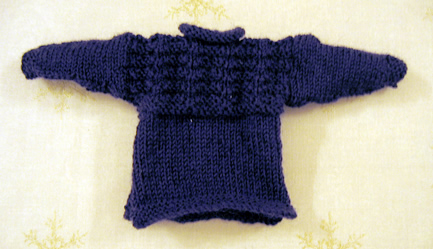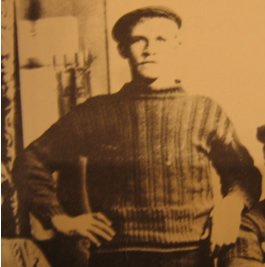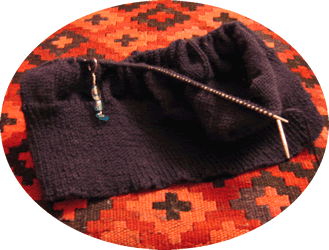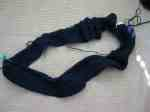Archive Entries for 2006
Thursday November 30, 2006
Christina: First ever gansey - complete
OK I admit it. It is very small. It may not fit George. It may not fit anyone over 12 inches in height.

Posted by Christina at 8:57 AM. Category: Ganseys
Wednesday November 29, 2006
Christina: "How to knit a gansey"
After a discussion at Alison's knitting group about how ganseys were originally made, I am posting this information, again taken from the lovely books by Michael Pearson. I need to say two things: this text and pictures are copied verbatim from the book, and this is probably the only source of information I have read; as the statements are sourced from knitters in Scotland and the NE of England, they are clearly true, but overall, there is no one method or technique, and it is also an obvious truth that different areas have different traditions.
Seam Lines
A seam line occurs, made up from a combination of purl and knit stitches, which runs up each side of the gansey. This device is designed to help the correction of the pattern by making a division for front and back. It also provides the base for a gusset, which is knitted under the arm to give freedom of movement, and extend the life of the gansey.
Circular Knitting
The circular knitting technique is the essential feature of ganseys, creating a seamless construction. This traditional method of knitting in the round is more natural to knitting than the more modern method of knitting over two needles. Knitting pieces and sewing them together owes more to dressmaking and tailoring than knitwear. Two needle knitting has arisen to accommodate difficult shapings demanded by fashion trends. The majority of old patterns were in the round. Shetland Islanders mention over and over again: “Never sew when you can knit”, and most people hate sewing the knitted pieces together. Circular knitting is achieved by knitting over 3, or 4 long straight needles.
The “Whisk”
 To speed up the knitting, apart from the obvious mechanism of the technique, the most significant method was to anchor the working needle so that the knitter can use the fingers of the right hand to move the stitches from the left hand needle. This enabled the average knitter to knit “two cuts a night” (4oz which is 115g), at around 200 stitches a minute. The most popular of these anchors was the sheath or a stick, strapped or pinned to the waist. The stick was about 10 inches long, with a hole at the top for placing the needle. The sheath was made of leather, stuffed with horse hair, and attached to a belt fitted around the waist (see photo).
To speed up the knitting, apart from the obvious mechanism of the technique, the most significant method was to anchor the working needle so that the knitter can use the fingers of the right hand to move the stitches from the left hand needle. This enabled the average knitter to knit “two cuts a night” (4oz which is 115g), at around 200 stitches a minute. The most popular of these anchors was the sheath or a stick, strapped or pinned to the waist. The stick was about 10 inches long, with a hole at the top for placing the needle. The sheath was made of leather, stuffed with horse hair, and attached to a belt fitted around the waist (see photo).
There were other methods:
Mrs Leith from Orkney: “… leather belts are sometimes used… personally I prefer the safety pin stuck firmly in the bodice, a little above the belt on the right hand side. I have seen a bunch of feathers used, stuck in the belt….”
Mrs Keith from Lossiemouth in 1959: “a ‘wisker’ was a bunch of straw stuffed inside an old sock and tied to the waist…”
The Patterns
The tradition was an aural one – the information and expertise passed down generation after generation. Many of the knitters now too old to knit explained their patterns by repeating the rounds they used to chant, or the pattern was deciphered through close examination of archival photographs taken around 1900. The shape of the gansey relates to bridal shirts and smocks of earlier centuries. The arms and cuffs are knit down from the shoulder and cast off at the cuff (the opposite of modern knitwear), to enable one to repair any worn parts by simply pulling back the past the hole and knitting back down again to the cuff.
Posted by Christina at 11:48 PM. Category: Ganseys
Tuesday October 31, 2006
Christina: Old gansey
As this gansey project is obviously going to be ongoing for quite a while I thought I'd include this old gansey photo that illustrates our previous exchange of comments. I could not find an exact photo of a very wide ribbed welt, but many of the ganseys have some kind of wide "belt" around the middle, formed as part of the pattern.

Posted by Christina at 11:11 PM. Category: Ganseys
Saturday October 28, 2006
Christina: Whitby Gansey - All plain sailing
I have used up my first 100 gram ball of wool; that is: all bar the last 6 inches as a moth seems to have chewed through the thread very near the end. Little to report except lots of plain knitting.
I am purling only one stitch at each side, and Alison's gift of lovely bead placement markers are really coming into their own. I hardly have to concentrate at all - though this has lead to a dropped stitch, which I had to pick up some half a dozen rows down. The knitting is so tight on the fine needles that the extra tension has not distorted the fabric at all noticeably.
I never understood the stuff about dropped stitches; when I was young, it seemed to be a major topic for knitters and a key indicator of knitting incompetence. Growing up, I thought you would have to be a real ninny to (a) drop a stitch in the first place, and (b) not be able to easily correct it. Lately, I have knitted a couple of vintage 3 and 4 ply patterns where the instructions "cast on 328 stitches" is not so uncommon, my eyesight is not so acute, and I am a little more humble. Going to the trouble of counting your stitches, finding one short, and having to examine the stitching to find out where it might have gone is .... well... needles and haystacks spring to mind.

Posted by Christina at 2:16 PM. Category: Ganseys
Sunday October 22, 2006
Alison: Caister Gansey - It's a start
I have completed the 20 rows of the welt and started the body of my sweater.

It's slow going, especially as I keep poking myself with my needles. The knitpicks circular needles are really nice, especially the cord which is much more flexible than Addi Turbo needles, but they are very pointy. I don't think I could manage with a less pointy needle though because the gauge is so tight.
Other than all that winging, I really like the knitted fabric. It's nice and firm, just like a real guernsey!
Posted by Alison at 7:48 PM. Category: Ganseys
Monday October 9, 2006
Alison: Caister Gansey - the start
I have chosen the Caister Gansey from The Traditional Sweater book by Madeline Weston. Here is the work so far - my wool and swatches. Result of the swatching means that I need to use 2mm needles - so part of the reason for selecting the Caister Gansey is that I can actually get the correct tension.

The wool came from Frangipani, who provide a sample pattern - but with a tension of 36 st to 10cm and, even on 2mm needles, I really couldn't get close. The Caister Gansey is 28sts which I can achieve on the 2mm. I also wanted a fairly plain guernsey pattern as I cant really see my Father (planned recipient) wearing anything more complex or patterned, lovely though they are; I might even leave off the cables on this pattern and stick to a knit/purl pattern, which think is more traditional.
Posted by Alison at 8:15 PM. Category: Ganseys
Friday October 6, 2006
Christina: Whitby Gansey - the start
This is Mrs Laidler's pattern from the book "Fisher Gansey patterns of NE England" by Michael Pearson; this is a lovely booklet, now out of print but sometimes seen on eBay. The patterns in this book are described rather than written in detail, and there is basically only one size quoted (differs by pattern) - you can adapt the sizes but for some of the patterns this is difficult. I chose this pattern because it is knitted in the round, and has the traditional features of saddle shoulders, and under-arm gussets.
The wool (Creskeld - now called British Breeds 5 ply) knits up to 27 sts to 4 inches (10cm) on No 12 (2.75mm) needles. So far I have "cast on 300 loops", and started the welt.

Posted by Christina at 2:07 PM. Category: Ganseys
